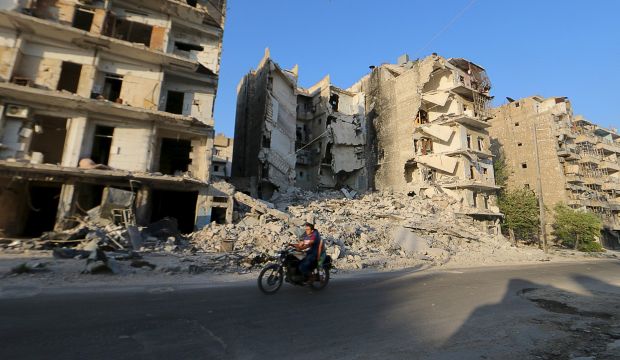
Residents ride a motorcycle past damaged buildings in a rebel-controlled area of Aleppo, Syria, on July 24, 2015. (REUTERS/Abdalrhman Ismail)
The US is using Syrian air space to lead a campaign of air strikes against the Islamic State of Iraq and Syria (ISIS), and a greater Russian presence raises the prospect of the Cold War superpower foes encountering each other on the battlefield.
Both Moscow and Washington say their enemy is ISIS, whose Islamist fighters control large parts of Syria and Iraq. But Russia supports the government of Assad in Syria, while the US says his presence makes the situation worse.
In recent days, US officials have described what they say is an increase of Russian equipment and manpower.
President Barack Obama said this would not change US strategy in countering ISIS fighters, which includes US planes leading an international coalition in airstrikes in Syria.
“But we are going to be engaging Russia to let them know that you can’t continue to double-down on a strategy that is doomed to failure,” he said at an event with military service members during a visit to Maryland.
In the latest reports, two Western officials and a Russian source told Reuters Moscow is sending advanced SA-22 anti-aircraft missiles to Syria. The system would be operated by Russian troops, rather than Syrians, the Western officials said.
US officials in Washington also said they believed about 200 Russian naval infantry forces were now stationed at an airfield near the Syrian city of Latakia, an Assad stronghold, and that the number had increased in recent days.
At a news conference in Moscow, Foreign Minister Sergei Lavrov said Russia was sending equipment to help Assad fight ISIS. Russian servicemen were in Syria, he said, primarily to help service that equipment and teach Syrian soldiers how to use it.
Russian naval exercises in the eastern Mediterranean were long-planned and in accordance with international law, he said.
A source close to the Russian navy told Reuters a squadron of five Russian ships equipped with guided missiles had set off to conduct maneuvers in Syrian waters.
“They will train to repulse an attack from the air and to defend the coast, which means firing artillery and testing short-range air defense systems,” the source said, adding that the exercise had been agreed with the Syrian government.
Russia has given notice of several rounds of navy drills with rocket firing tests in the sea off Syria from September 8 to October 7, according to Cypriot aviation authorities and international governmental databases of notices for airmen. Some flight paths will be temporarily closed.
Undesired, unintended
Lavrov blamed Washington for cutting off direct military-to-military communication between Russia and NATO after the crisis in Ukraine last year. Such contacts were “important for the avoidance of undesired, unintended incidents”, Lavrov said.
“We are always in favor of military people talking to each other in a professional way. They understand each other very well,” Lavrov said. “If, as (US Secretary of State) John Kerry has said many times, the United States wants those channels frozen, then be our guest.”
US officials say they do not know what Moscow’s intentions are in Syria. Momentum in Syria’s 4-year-old civil war has been shifting against Assad’s government, which has suffered battlefield setbacks this year at the hands of an array of insurgent groups.
Moscow, an ally of Damascus since the Cold War, maintains its only Mediterranean naval base at Tartus on the Syrian coast, and defending it would be a strategic aim.
In recent months NATO-member Turkey has also raised the prospect of outside powers playing a greater role in Syria, proposing a “safe zone” near its border, kept free of both ISIS and government troops.
Common enemy
The war has killed 250,000 people and driven half of Syria’s 23 million people from their homes. Some have travelled to European countries, creating a refugee crisis there.
The dispatch of advanced anti-aircraft missiles like the SA-22, which the two Western officials said were on their way but had not yet arrived, would appear to undermine Moscow’s argument that its sole aim is to help Damascus fight ISIS: the militants and other insurgents possess no aircraft.
“This system is the advanced version used by Russia and it’s meant to be operated by Russians in Syria,” said one of the Western sources, a diplomat briefed on intelligence assessments.
A Russian source close to the navy said the delivery would not be the first time Moscow had sent the SA-22, known as Pantsir-S1 in Russian, to Syria. The system had been sent in 2013, the source said. “There are plans now to send a new set.”
However, the Western diplomat said the new missiles would be more advanced than those deployed in the past.
French Foreign Minister Laurent Fabius said it was too early to judge what Russia’s motivations were in Syria, but “adding war to war” would not help resolve the conflict.
“If it’s about defending the base in Tartus, why not? But if it’s to enter the conflict….” he said, without finishing the thought.
